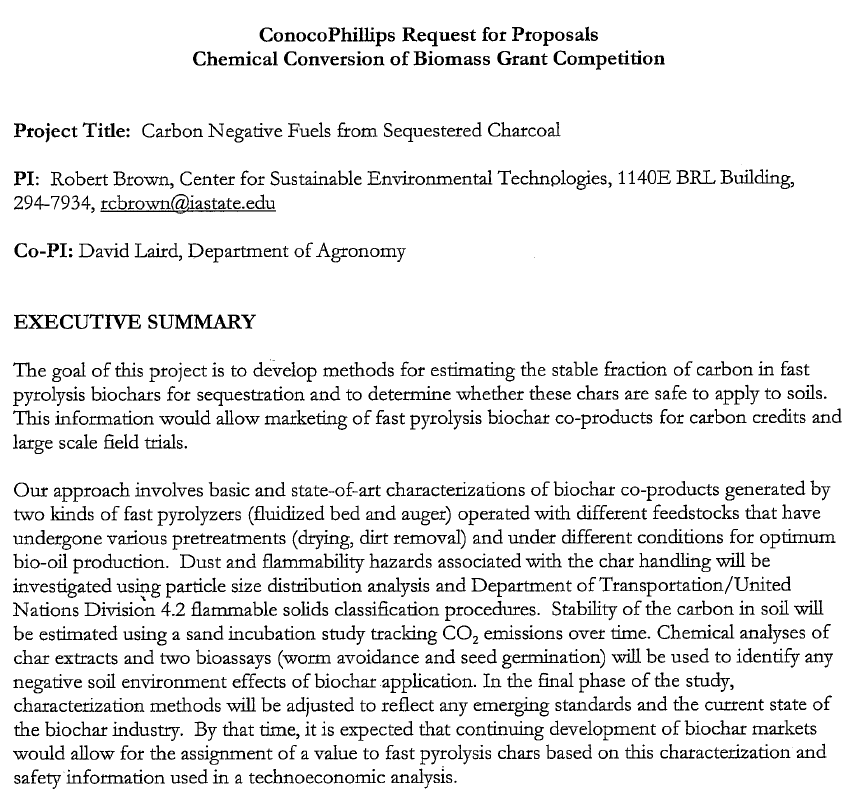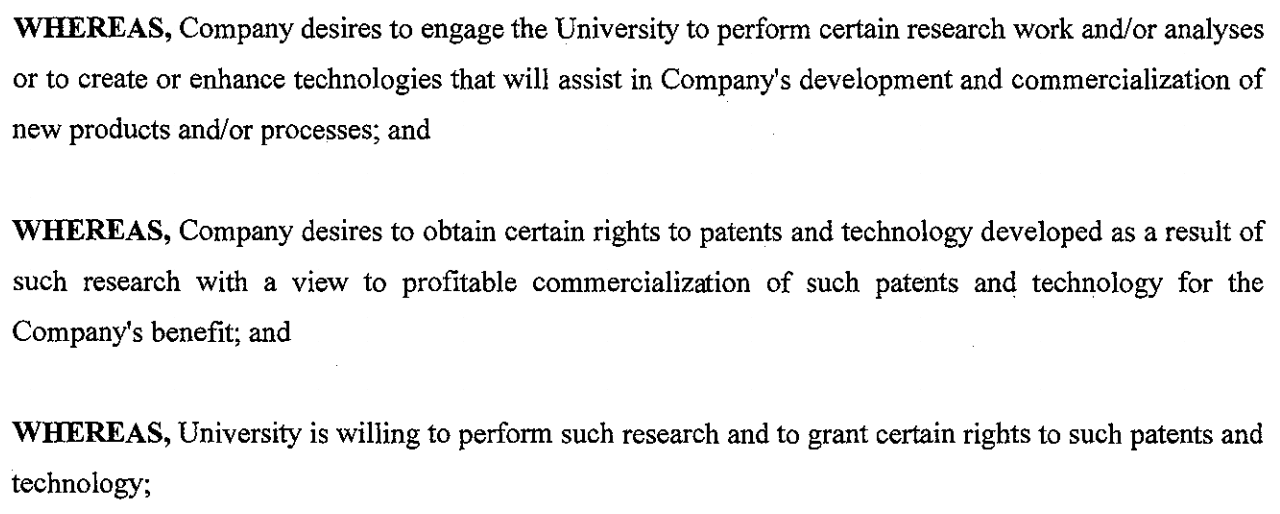For the past several years, a well-organized, well-funded campaign has worked to include biochar in prospective carbon markets as an approved offset for greenhouse gas emissions.
The ardent push has occurred even though the non-partisan Government Accountability Office gave biochar a Technology Readiness Level of two out of nine in a July 2011 report and a 2015 National Research Council study on geoengineering came to similar conclusions about biochar. It also unfolded even though the climate change mitigation potential of sequestering biochar into the ground is far from a settled fact and long-term field trials are sorely lacking.
And then there’s the science of offsets in and of itself, which is also rife with contention.
Supporters say offsets have the ability to curb the climate change impacts tied to emitting greenhouse gases into the atmosphere. Detractors, meanwhile, say they only further encourage more greenhouse gas pollution and are, at their core, a “rip offset” for economic reasons and an ecological public relations “greenwashing” tool.
Couple the dubious science behind biochar with the fact offsets are also scientifically questionable, and you get a perfect pseudo-science storm. Still, none of this has stopped the biochar lobby from making a big marketing push for the acceptance of biochar offsets.
Several oil companies have also promoted using biochar as a reclamation tool for cleaning up damaged lands in Alberta, Canada, home of the tar sands boom, even though tar sands reclamation — like offsets — is scientifically unproven. Similarly, some biochar advocates say biochar could reclaim oil and gas hydraulic fracturing (“fracking”) sites upon completion of drilling.
Biochar Offsets Bet
One cannot understand the biochar lobby’s offset-centric policy strategy and its attempt to place biochar within climate agreements without first closely examining the International Biochar Initiative (IBI).
IBI was formed in June 2006 as an offshoot of the World Soil Science Congress, just a few months after Nature published a major feature article about biochar featuring IBI Board Chairman and Cornell University Professor Johannes Lehmann. At the time, IBI was known as the International Agrichar Initiative. Here’s how IBI explains its genesis:
At the 2006 meeting, individuals and representatives from academic institutions, commercial ventures, investment bankers, non-governmental organizations, federal agency representatives, and the policy arena from around the world acknowledged a common interest in promoting the research, development, demonstration, deployment (RDD&D) and commercialization of the promising technology of biochar production.
IBI immediately set out to formulate a mass-marketing strategy for biochar. Thus far, that strategy has centered around offset protocols for biochar on both domestic and international scales, even as hard scientific proof of the substance as a climate change mitigation device awaits the crucible of field trials.
Since its inception, the IBI has made several pushes to have biochar included in both international climate agreements as well as in domestic climate agreements in various countries around the world.
The group has had some modest success, getting biochar inserted into:
a) Various negotiating documents in the UN Framework Convention on Climate Change in the carbon trading and sequestration sphere. None of these made it beyond the negotiating phase.
b) A carbon offset bill in the United States, the Clean Energy Partnerships Act of 2009, specifically calling on the U.S. government to “establish and maintain a list of types of offset projects eligible to generate offset credits under the program.” The bill ended up dead on arrival.
c) A stand-alone biochar subsidy bill in the U.S., the WECHAR Act of 2009 (H.R. 3748/S. 1713). WECHAR is shorthand for “Water Efficiency via Carbon Harvesting and Restoration.” The environmental group Natural Resources Defense Council (NRDC) employed the head of its water program, Ed Osann, to lobby on behalf of the bill for two lobbying quarters.
Introduced by U.S. Rep. Shelley Berkley (D-NV) and U.S. Sen. Harry Reid (D-NV), the bill calls for the U.S. government to “establish loan guarantee programs to develop biochar technology using excess plant biomass, to establish biochar demonstration projects on public land, and for other purposes.”

U.S. Rep. Shelley Berkley (D-NV), Image Courtesy of Wikimedia Commons
This bill gained zero traction, with one co-sponsor in the House version and five in the Senate version, respectively.
With Big Oil Friends Like These…
IBI has close financial and personnel ties to companies with a major stake in fossil fuel development.
In 2007, with IBI in its infancy as the biochar industry’s lobbying voice, ConocoPhillips Canada gave Iowa State University (ISU) an eight-year $22.5 million grant to do biofuels research and development work, including on biochar. That grant has run dry, but ExxonMobil has filled its void, giving ISU a two-year, $1 million grant in 2014 to do similar research.
Documents obtained via Iowa’s Open Records Law by DeSmog reveal that the entire premise of the biochar research ISU did, just above $90,000 of which was set aside for biochar-related matters, was to serve as an impetus to get carbon credits as part of a carbon market.
Image Credit: Iowa State University
The terms of the research agreement contract signed between ISU and ConocoPhillips, also obtained by DeSmog, came under fire in a 2010 report authored by the Center for American Progress (CAP) titled, “Big Oil Goes to College.”
“This agreement leaves ConocoPhillips in charge of almost all facets of the research alliance,” wrote CAP. “The agreement fails to spell out any formal governance structure, method of collective decision-making, or system of voting to guide the management of this eight-year university-industry research collaboration.”
The agreement also gave ConocoPhillips full patent and commercialization rights over the research.
Image Credit: Iowa State University
Furthermore, the same set of ISU researchers now have funding to do biochar research via Stanford University’s Global Climate and Energy Project, part of a broader $9.3 million grant announced on August 12, 2015, going toward the “study [of] the production of biochar for use as a soil amendment that stores carbon underground instead of allowing carbon dioxide to re-enter the atmosphere as the plant decomposes.”
The Stanford research is funded by ExxonMobil, GE, Schlumberger, DuPont and Bank of America, all of which have financial or operational ties to Alberta’s tar sands and other oil and gas reserves.
“I guess I would have to say that most of the companies involved saw value in our carbon sequestration proposal,” ISU engineering Professor Robert Brown told DeSmog via email. “The project is strictly analysis of the potential for carbon sequestration in the U.S., the costs, and the potential economic potential. The mechanism for deriving benefits [such as carbon markets, carbon systems, etc.] will be considered by our economists.”
A subset of those same researchers also locked down a $3.5 million grant from Chevron to study advanced biofuels. Among them included on the list: biochar.
“This latest pilot plant at Iowa State’s BioCentury Research Farm is a joint project with Chevron U.S.A. University engineers are using the pilot plant to develop and demonstrate an advanced biorenewables technology called solvent liquefaction,” reads an ISU press release from September 2016. “The technology converts biomass such as quarter-inch wood chips into a bio-oil that can be processed into fuels or chemicals and a biochar that can enrich soils.”
ISU‘s biofuels program is run by Brown, a mechanical engineering professor. He also serves as a consultant for Dupont and Syncrude Canada, both of which have a major stake in Alberta tar sands development.
The consulting firm that helped spearhead and draft the biochar offsets protocol for the American Carbon Registry, which was eventually rejected, got its seed money from ConocoPhillips Canada. That firm, Biochar Protocol Development, no longer exists.
Beyond pure offsets, several oil companies have proposed using biochar as a reclamation tool for cleaning up ravaged tar sands extraction lands in Alberta, as well as fracking lands, which in turn will count as an “offset” once the damage is done.
A Fossil Fuel Champion for Biochar Reclamation Offsets
Beginning in 2007, natural gas company Encana’s Subodh Gupta began a push to include biochar in a sweeping carbon offset plan. Today, Gupta is head of technology development at Canadian oil company Cenovus, as well as the manager of research and development of its oil sands division.
Gupta presented the idea in a fall 2007 journal article, published in the Society of Petroleum Engineers’ One Petro, entitled “What Are Our Options for Sequestration of Atmospheric CO2—Some Thoughts“ on the topic of carbon sequestration.
The article relies on the assumption that the world is dependent on fossil fuels and will only grow increasingly so over time.
Gupta wrote:
Use of fossil fuel ever since the dawn of the industrial age has led to increased level of CO2 in the environment. Our world today is fueled mainly by fossil energy and it is unlikely that this dependence will significantly change in the near future. This coupled with the fact that majority of the developing world is at the beginning of the economic growth which is implicitly energy-intensive, the concentration of CO2 in atmosphere will only increase in the business-as-usual case.
Business-as-usual for oil and gas extraction, then, is the working assumption behind Gupta’s scholarship, which makes sense given he works as an industry researcher.
In that same paper, Gupta proceeded to extol the virtues of sequestration “of biomass through its conversion to charcoal” (aka biochar).
Later, in an October 2009 paper appearing in the same journal and relying on the same assumptions, Gupta discussed working biochar into an offset plan for the first time. This paper, titled, “Are There Less Costly Ways to Sequester Carbon Than CCS?” was presented at the Society of Petroleum Engineers’ annual conference in New Orleans, Louisiana.
Just weeks later, on October 29-30, Gupta traveled to Edmonton for the Alberta Offset System’s 2nd Round Quantification Protocol Stakeholder Review. That review’s attendee list included representatives from the likes of ATCO Pipelines, Alliance Pipeline, ConocoPhillips Canada, Husky Energy, Kinder Morgan Canada, Shell Canada, Suncor Energy, and TransCanada.
Fast-forward roughly a year and a half to the 2011 World Heavy Oil Congress. At the Congress, Gupta championed inserting biochar into an offset protocol, such as the Alberta Offset System.
He also told the audience of Cenovus’ desire to transform industrial lands in Alberta into a biochar reclamation project.
“What Gupta’s team is tasked with is developing equipment that can convert that waste to biochar at a large enough scale to offset some of the company’s carbon footprint,” explained Alberta Oil Magazine. “Gupta says his project team is perhaps a year or a year-and-a-half away from proving its camp waste-to-biochar technology works.”
Gupta says he hopes Cenovus will serve as an example to others if this model succeeds.
“This will not solve all the world’s emission problems,” he told Alberta Oil Magazine. “But it’s a legitimate baby step in convincing others that this is a viable way to offset carbon emissions.”
Coming full circle, the Foster Creek project, where Cenovus is planning its tar sands “waste-to-biochar” reclamation project, is co-owned on a 50-50 basis in partnership with ConocoPhillips, key funder of biochar research and development at ISU and provider of seed money for Gaunt’s firm Biochar Protocol Development.
The “baby step” has convinced others that biochar can also serve as a tar sands land reclamation tool.
Biochar Solutions and Biochar Reclamation
Biochar Solutions is another company getting in on the rush to “offset” tar sands extraction through biochar development. On Nov. 2, 2011, Biochar Solutions became a finalist for the $25 million Earth Challenge Prize, an award presented by Virgin Group.
Headquartered in Carbondale, Colorado, Biochar Solutions announced it would form a subsidiary in Canada — Biochar Solutions Canada — roughly two weeks after it became a prize finalist.
Biochar Solutions will follow in the footsteps of Cenovus and ramp up efforts to “reclaim” tar sands extraction sites with biochar. The company has already reclaimed one mining site in Colorado called Hope Mine, a former silver mine.
The mine was described by The Colorado Independent as a former “wasteland of arsenic, cadmium, lead and zinc,” paralleling what tar sands sites may resemble in the aftermath of tapping into the oil found within them.
The co-owner of Biochar Solutions, Morgan Williams, is elated with the prospect of utilizing biochar to reclaim tar sands extraction sites. In a press release announcing the launch of the Canadian subsidiary, he stated:
We are happy to formally begin our work in Canada…Western Canada faces massive carbon challenges ranging from standing dead timber from beetle kill in British Columbia, to the carbon emissions associated with mining and oil sands development. Our biochar technologies offer nexus solutions to begin addressing forestry, climate and land reclamation challenges simultaneously.
Not mentioned by Williams: climate change impacts from tar sands extraction are a major cause of dead timber from beetle kill to begin with. In January 2017, the Colorado General Assembly passed a resolution calling for the expanded use of biochar in the state, which cited uses paralleling those being deployed by Biochar Solutions.
Image Credit: Colorado General Assembly
A depiction of the company’s dedication to using biochar to “offset” tar sands development, Biochar Solutions Canada co-owner Len Eddy also has made a career out of promoting offsets.
Representing his two former employers, AgCert International and The Carbon Basis Company, government records reveal Eddy was, like Gupta of Cenovus, involved in technical review and protocol development meetings for the Alberta Offset System.
Additionally, both of the firms Eddy worked at while he sat at Alberta Offset System review meetings were major proponents of carbon trading and offset markets. And during his time working for PricewaterhouseCoopers (PWC), Eddy developed an expertise in emissions-trading offsets markets, according to an archived biography on PWC‘s website.
Fracking and Biochar Reclamation
In September 2014, University of Texas-San Antonio (UTSA) researchers concluded in a study that, as others have said with regards to the Alberta tar sands, biochar can also reclaim ravaged fracking sites.
Specifically, the researchers said it could be used to treat fracking wastewater, known by some as “flowback.”
“There are many variables that go into making different types of biochar to filter certain chemicals, including the material composition of the biochar and to what temperature it’s heated,” said UTSA mechanical engineering professor Zhi-Gang Feng, one of the study’s co-authors, in a press release. “Our research demonstrates that this is a product that can reduce the environmental impact of drilling in a way that is safe and inexpensive to industry.”
Study: Impossible to “Reclaim” Tar Sands Sites
The up-and-coming biochar industry’s business model with regards to oil and gas offsets and reclamation rests on a big assumption: that it’s actually doable to reclaim tar sands extraction sites once the damage has been done.
Yet according to a study published in March 2012 in the peer-reviewed journal Proceedings of the National Academy of Sciences, tar sands reclamation is more fiction than fact. The study says:
Claims by industry that they will “return the land we use—including reclaiming tailings ponds—to a sustainable landscape that is equal to or better than how we found it” and that it “will be replanted with the same trees and plants and formed into habitat for the same species” are clearly greenwashing.
Research on fracking reclamation, given the relative newness of the boom, is also sorely lacking.
Some things are scientifically certain, though: industrialized tar sands extraction is one of the most greenhouse gas–intensive methods of fossil fuel production on the planet. And fracking has quite the greenhouse gas emissions footprint itself.
And to date, no scientific evidence exists to support that stuffing biochar into the ground after tar sands extraction or natural gas fracking can actually “offset” these processes’ impacts or greenhouse gas emissions.
Regardless, in one of IBI‘s responses to a public comment on its biochar offsets development protocol (shot down by the American Carbon Registry), IBI disclosed that they are still working on drafting up a protocol for the Alberta Offset System.
Continue to Part 5.



